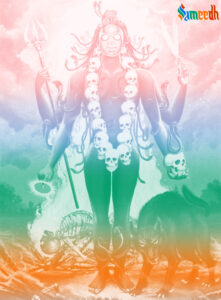Kala Bhairav is a manifestation of Lord Shiv and is often referred to as the deity of time, the controller of time, or the Lord of Time. The term “Kala” in Sanskrit means time, and “Bhairav” denotes the fierce aspect of Shiv. Kala Bhairav is depicted as a fierce and terrifying form, symbolizing the destructive and transformative nature of time.

Kala Bhairav is one of the most well-known forms of Bhairav and is one of the forms of Lord Shiv. The word “Kala” refers to time, and Kala Bhairav is often depicted as the controller of time, emphasizing the transient nature of life.
Here are some key aspects and attributes associated with Kala Bhairav:
- Symbolism of Time: Kala Bhairav is often depicted as carrying a human skull, which symbolizes the transience of life and the mortality of all beings. The image emphasizes the inexorable passage of time and the impermanence of the material world.
- Eight Forms: In some traditions, Kala Bhairav is worshipped in eight different forms, each associated with a specific attribute. These eight forms are believed to represent various aspects of the deity’s power and influence.
- Guardian of Temples: Kala Bhairav is considered a guardian deity of Shiva temples. It is believed that he guards the sacred spaces and protects devotees from negative forces.
- Vehicle: Kala Bhairav is often depicted riding a dog, which is his vahana (vehicle). The dog is symbolic of loyalty and also represents the transient nature of life.
- Role in Hindu Mythology: There are various legends associated with Kala Bhairav. One popular story involves Kala Bhairav cutting off the fifth head of Lord Brahma due to Brahma’s arrogance. This act symbolizes the control of time over creation.
- Worship: Devotees worship Kala Bhairav to seek protection, guidance, and blessings. Special prayers and rituals are performed on Kala Bhairav Ashtami, which falls on the eighth day of the Krishna Paksha (waning phase of the moon) in the Hindu month of Margashira.
- Mahakala Bhairav: In some traditions, Kala Bhairav is also referred to as Mahakala Bhairav, emphasizing the deity’s connection to the great time cycle and the cosmic order.
Devotees believe that by worshipping Kala Bhairav with devotion and sincerity, they can overcome the fear of time, attain spiritual progress, and ultimately achieve liberation (moksha).
It’s important to note that Kala Bhairav is a revered deity in the Shaiva tradition within Hinduism, and his worship is associated with both the destructive and protective aspects inherent in the cycle of time.
